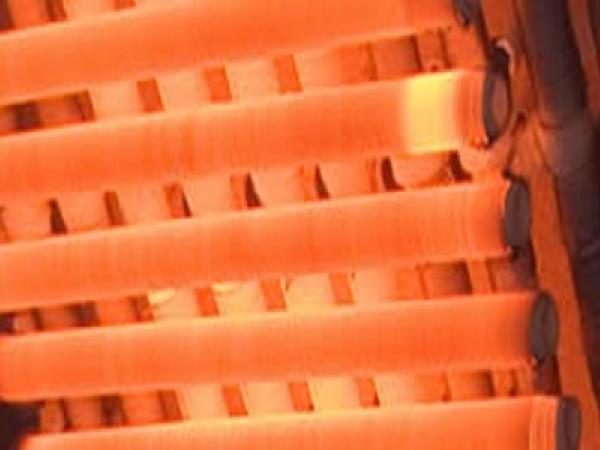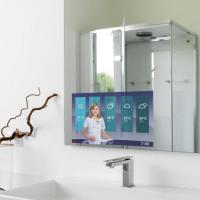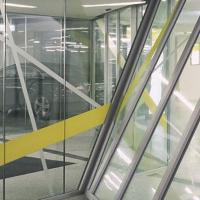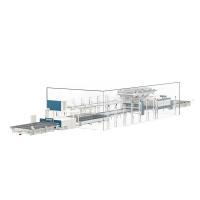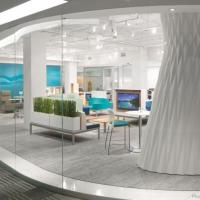However traditional gravity bent tempered processing still exists and new bending & tempering machinery is being developed for this processing method. Most important benefits of this tempering method based on the forming by gravity bending are smaller investments and tooling costs and ability to produce small series.
However two-way bent tempered glazing produced with gravity bending is one of the most challenging forming processes in the safety glass industry when it comes manufacturing furniture, architectural, special vehicle, automotive or marine glazing.
General principles between gravity bending (bent laminated glasses) and gravity bent tempered processes are quite similar, but producing bent tempered glazing using gravity bending method can be especially challenging. Sag and shape of the glass are frequently the biggest challenges producing any gravity bent glazing, but with bent tempered glazing number of critical challenges/factors increase significantly. This article will review the challenges processing bent tempered glazing.
PRE-TREATMENT AND TOOLING
Cutting
To exclude any possible changes that may affect the breakage on the process we should be aware of glass tin side in each work step. Glasses should be handled so that the tin side of the float glass is against the mould frame or rollers during the processing.
It is known that cutting the glass on the tin side has a considerably lower flexural strength than when cut on the air side. This is due to the fact that cutting on the tin side results in cuts which are much more irregular than in the case of cutting on the air side.
Grinding
With precision and know-how in this pre-processing stage it is possible to achieve significant savings with reduced waste in tempering. Grind wheel must be intact and evenly worn. Unevenly worn grind wheel will leave the other edge of the glass sharper, which is still as rough glass. All shellfishes, cracks and grinding holes are possible breaking points when the glass is processed. Sharp edge grinding is not recommended as number of waste will rise significantly in the tempering process.
Recommendable grind types:
- Semi-round grinding, so called C grind.
- Raw Edge grinding.
- Marginal gloss polishing.
Drilling
Drilling is the second pre-treatment phase which significantly affects in the amount of waste pieces in tempering process. Drilling has to be straight and the meeting point position of the drills should not be left article. The holes edge work is in great importance. Edges have to be smooth, not rough at all. Even a minor crack is a possible breaking point.
Screen printing
Screen print should be made on tin free side (air side) of the glass, as the tin side of the glass is against the mould frame or rollers during the bending. Screen print has to be completely dry or at least uniformly dried all over. Wet or thicker coats of ceramic paint in parts of the glazing will influence negatively on the stability of bending and tempering processes.
Tooling
One of the advantages of gravity bent tempered glazing is the fact that it does not leave tong marks where as in vertically bent tempering it is inevitable. Therefore gravity bent tempered glazing can applied without any covering, bulky frames nor other similar solutions used to hide processing marks.
In comparison to press bending the tooling cost are lower. However in addition to the bending and quenching challenges the gravity mould tooling itself creates further challenges in quality production.
The mould structure in gravity bent tempered glazing slightly differs from the standard gravity bending moulds. Since steel will absorb heat from the glass, causing unnecessary temperature variations, steel cannot be applied extensively in the region of glass or support structures located in close proximity of the glass as is often done in standard gravity bending moulds producing annealed laminated glass. These temperature variations can cause glass breakages during the quenching. Therefore the moulds are lighter in structure and frame.
To achieve perfect fragmentation cooling air requires a clear access to the glass surface. If cooling air flow gets blocked from the glass surface it will be seen as too large fragments in fragmentation test -procedure. To enable clear access of the cooling air mould frames should be equipped with air holes between the glass and the mould frame. In practice, the mould should be modified by careful notching the mould frame in suitable intervals to create holes where the air can freely flow/escape.

THE PROCESS
PREHEATING
Processing bent tempered glass the pre-heating is in great importance The glass is preheated in 1- 4 different chambers (depending on the manufacturer of the machine), raising the temperature gradually to the required temperature.
Too rapid heating or large differences in temperature between chambers can break the glass in the bending process or doing this can result as breakage during quenching. Settings of the heating profile are in great importance even at this early stage of heating.
BENDING
After the pre-heating the glass is heated in bending chamber/stage. In this stage the heat is applied to localized areas in order to achieve the required final shape. This is done setting the heating element profile so that it will heat the areas that require heating to bend.
Common product design with bent tempered glazing features a relatively flat middle section, virtually no cross curvature (sagging), while the edge shapes are deep, aggressive. Standard gravity bending, annealed laminated glazing, simply reducing the heating on the middle of the glass is possible to bend only minimal small sag.
In addition special tooling can be further applied to decrease the level of curvature at the mid pane, if necessary. Processing gravity bent tempered glazing these practices cannot be applied, as the center of the glass is often too cool or temperature differences are too great between edges and center of the glass.
Thereafter, the glass will next go to so called "quick-heating” chamber/stage with temperature conditions of over 800 °C. The purpose of the “quick-heating” is to compensate the temperature differences in the glass edges and middle section and rise the glass temperature to around 650 °C that is required to quench the glass successfully.
There is not just one ultimately correct way to bend the glass in bent tempered glazing. There can be as many ways to bend the glass to its final shape as there are operators – for certain modifications to glass shape can be numerous different solutions of adjustment, each giving more or less similar results.
Some operators may want to bend the glass in the bending chamber/stage or lift almost to the final shape, as others may process the final shape in the “quick-heating”- chamber/stage. The decision to the bending process adjustments is evaluated and executed according to the shape of the final product.
For example severe mould marks can be a result if the glass is already bent and is “sitting” against to the mould frame long periods in the bending chamber/stage and throughout the “quick-heating”-chamber/stage, where the temperature conditions are even hotter. In this scenario better solution and results can be gained keeping the glass slightly colder in the bending chamber/stage and bending the glass to its final shape in the quick-heat chamber/stage.
Keeping the glass relatively flat in the middle section as commonly required the processing can be similar as in the earlier “mould marks scenario”. In the bending chamber/stage the other parts of the glass are bent very close to the final shape, while maintaining only minimum heating condition in the middle section.
The glass is then bent to the required final shape in the “quick-heat” chamber/stage. Adjusting and creating correct heating condition with the heating element profile controls for the middle section requires experience, since balanced and even temperature conditions are required to perfectly temper the glass and gain successful results in fragmentation tests. To achieve all these properties during the processing, heating profile requires perfect settings from the very beginning of the heating process.
QUENCHING
The critical last step, quenching. After the glass is heated to the required uniform temperature conditions and shaped, it is transferred to the chiller, where the blowers blow cooling air to the glass surface causing rapid cooling of the glass surfaces. Initial air blow creates so called "shock" - state, and this rapid cooling changes the glass surface into a state of compression while the inner layer remains in tension.
The challenge at tempering/quenching phase is to control the process producing required material specifications in surface compression and tensile stress characteristics, simultaneously maintaining the correct in tolerance shape and geometry of the final product. Controlling this at the introduction of new products and possible problem shooting requires skilled machinery operator.
As in the bending in this quenching phase too there is not just one correct set-up to temper the glass successfully. Generally changes in the shape and distance of the cooling air nozzles will effect on the shape of the glass, while adjusting the air pressure effects on the size of fragments.
However in the end all these settings of the air nozzles and air pressure are linked to together when it comes to the results and the entire combination of each element will make the successful end results. Commonly the final shape of the glass is not adjusted in quenching. The quenching carried out with settings that equally and simultaneously maintains the bend shape and creates required material characteristics.
CONFIRMITY OF PRODUCTION
Depending on the glazing type and customer requirements finished glazing products will be tested for conformity of production. Commonly at minimum, the final product will be checked out, by measuring sagging (cross curvatures) at crucial geometrical points and product is compared against the checking fixture (jig) to see that size and shape are within specified tolerances.
Tests are also done to confirm optical quality, light transmission, and surface stress. To further reduce the risk of field breakages the glazing can be tested with Heat Soak method that accelerates nickel sulphide expansion. These test are carried out in individual intervals specified by the producer, existing standards, safety regulations, and customer. From these test the most challenging equation for the end product quality is the combination created by optical quality, geometry, and compressive stress quality requirements.
CONCLUSION
The increasing customer requirements, quality and design wise create challenges to the producers of bent tempered glazing. Almost limitless design possibilities in today’s safety glass applications bring major challenges for the glazing manufacturers by trying to implement even the wildest ideas in regards of the shape and size of the glazing. Co-operation between the glass producers and their customers is essential.
Expertise from the glass industry in the design phase of the glazing, is required as sometimes even the smallest changes in the design, for example adjusted hole positions or minor modifications in the cutting radius, can reduce considerably the undesirable and expensive waste.
Furthermore this co-operation and careful design can lower the product costs considerably, and improve the competitiveness of all parties, while the changes in the glazing design remain barely unnoticeable.
Expertise is a must to remain competitive and successfully deliver quality glazing products to the customers with affordable prices, still leaving enough margin for the company to survive during these challenging times. Training and consulting services designed to help glazing producers are available and external and objective expertise offers smoother way to further success, where the return to investment is guaranteed.
Author: Janne Mustonen
Co-author: Mika Eronen

